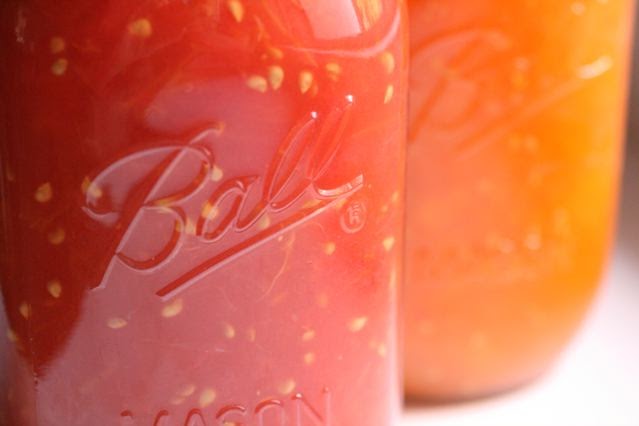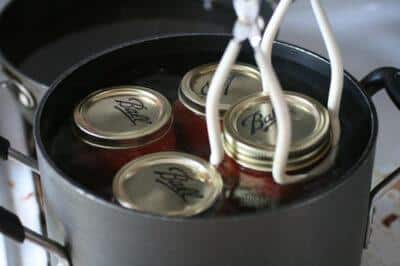It is never more gratifying to be a gardener than when luscious ripe tomatoes are rolling off the plants and into our kitchens. For most of us, though, there are often far more tomatoes than we can eat at the time. After slicing, sautéing, roasting, making salads and salsa, adding to pizza and ratatouille and grilled burgers, and filling the freezer with sauce, there is only option left.
Canning Tomatoes
It is time to can tomatoes. People have been canning tomatoes for long enough that everyone and their great-grandmother—and I do mean that literally—has strong opinions on how it should be done. Some folks use strictly paste tomatoes, meaning only those varieties developed specifically for use in homemade sauces. Others use any varieties of tomatoes at all, from commercial or traditional to heirloom, in all shapes and sizes.
There is no single correct answer when it comes to the best tomato varieties for canning. The primary difference is that paste types usually have less water content and require less reduction for sauces and ketchup. Taste, texture and personal preference are factors that matter.
The thing about canning tomatoes is that there are a lot of choices, not the least of which is whether to use a pressure canner or a boiling water bath canner. And the right answer to this question is that both methods are correct.
Pressure Canner or Boiling Water Bath Canner
This is unusual. For almost every other food, there is only one right choice. All vegetable, meats and seafood products need to be pressure-canned for safety. And while fruits can be processed using a pressure canner, it would diminish the quality of the product.
So why can tomatoes go either way? To explain, let me first talk about acid. The value of various foods are either very acidic—which registers very low numbers on the pH scale—or very neutral and registering very high pH numbers.
Almost all fruits range from 3.0 to 4.0 and are considered to be high acid. Vegetables range from 4.8 to 7.0 and are considered to be low acid.
Tomato Acidity
And then there are tomatoes. The average tomato sits at 4.6, right on the cusp of high acid versus low acid. In this sentence, “average” is the key word. If the average is at 4.6, that means there are some varieties that are a tad more acidic, and a few—particularly some of the heirloom types—that are a little less acidic.
Therefore, the safety rule with tomatoes is to acidify them. By adding a little acidic content to every jar of canned tomatoes, we can be absolutely sure that they are adequately acidic. Just a tablespoon of lemon juice or ¼ teaspoon of citric acid per pint of tomatoes does the trick when canning tomatoes. It is super easy, inexpensive and does not affect the taste of the finished product.
It may sound as if it is alright to skip the acidification step—adding the lemon juice or citric acid—if you are pressure canning, but that is not the case. You need to add acid with both processes, and here is why. The directions and processing times for both canning methods have been tested using acidified tomatoes. If you do not use added acid, the processing times given may not be adequate.
The major difference in canning tomatoes using the boiling water bath method versus pressure canning is processing time.
Processing time
For example, tomatoes packed in water take 40-50 minutes (depending upon the size of the jars) in a boiling water bath canner and only 10 minutes in a pressure canner. Tomatoes with no added liquid take a whopping 85 minutes in a boiling water bath canner and 25 minutes in a pressure canner. With crushed tomatoes, there is a huge time difference as well—35 to 45 minutes versus 15 minutes.
However, there is more than just processing time to consider when canning tomatoes. Using a pressure canner involves 10 minutes of venting, several minutes to build pressure, and more time to depressurize after processing. When you add it up, the actual time differences are less dramatic.
So why use a pressure canner for tomatoes? Many people say it is about the quality of the finished food. Pressure canned tomatoes often have brighter colors and flavors, retaining more of that tart zing that only a fresh backyard tomato can pack.
Prepare now for surging food costs and empty grocery store shelves…
Either way, there are some basics to go by. Following is a synopsis, although complete step-by-step directions can be found either in Ball’s Blue Book Guide to Preserving, which can be purchased for under $10 at most stores, or accessed free online at the National Center for Home Food Preservation.
Prepare your supplies for canning tomatoes. Wash and rinse jars and lids, and keep warm. Assemble equipment: canner, jar lifter, funel and head-space tool.
- Peel tomatoes by dipping in scalding water until skin loosens, plunge in ice water to make them cool enough to handle, and pull nskins off. Trim ends. Cut or crush as needed for recipe.
- Prepare your canner and heat the water to simmering.
- Add lemon juice or citric acid to each jar.
- Pack tomatoes according to recipe: crushed, whole or halved packed in water or tomato juice, or whole or halved with no liquid added. Add salt if desired.
- Remove air bubbles, wipe rims, and adjust lids to finger tight.
- Process in either boiling water bath canner or pressure canner, following times and procedures for the one you are using.
Methods vs Processing Time
You cannot safely mix and match processing times. It will not work to use pressure canning times in a boiling water bath canner, or to go with times given for whole tomatoes with added liquid for crushed tomatoes. If using the boiling water bath method for whole tomatoes, follow that recipe to the letter.
I have been canning tomatoes for a while and have used very nearly all of the permutations—with liquid and without, whole and crushed, boiling water bath or pressure canner processed. However, I admit that I do not have a single go-to way of doing it. An hour and 25 minutes is a long process time, but once it’s boiling, I can set it and forget it. Pressure-canned tomatoes do seem a little tastier, but it is more of a multi-step process than a boiling water bath. Crushed tomatoes are easier to pack into jars, but require more prep work and yield a product that I tend to use less in recipes. Most years, I do a variety.
Even though it seems a little more complicated at the outset, tomatoes are the perfect food for canning and are just right for those who prefer a wide variety of methods. And as long as you use an approved recipe, there is no wrong way to can garden-fresh tomatoes.
What canning advice would you add? Share your tips and secrets in the section below:
 Off The Grid News Better Ideas For Off The Grid Living
Off The Grid News Better Ideas For Off The Grid Living






